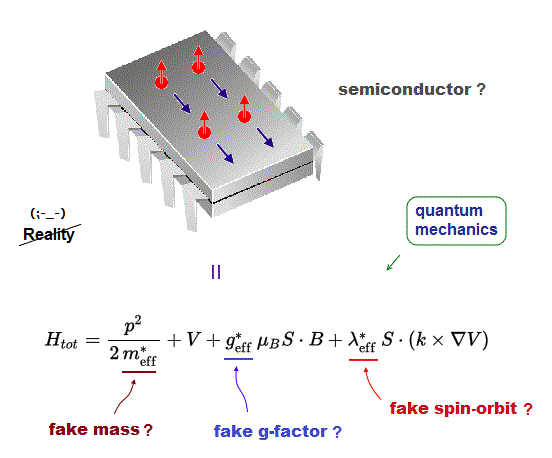
Home page
Electron spin is unreal
Spintronics is irrelevant to spin
Skyrmion quasiparticle memory is unreal
(Fig.1) Quantum mechanical spin hampers and contradicts spintronics, MRAM.

Magnetic (or magnetoresistive ) random access memory (= MRAM ) is a type of non-volatile memory storing data as two ferromagnetic materials' magnetizing direction ( this-background, this-middle ).
This MRAM representing spintronics is based on giant magnetoresistance (= irrelevant to quantum mechanical spin ) where two parallel (or antiparallel ) magnetizations in two adjacent ferromagnets causing low (or high) electric resistance is measured as bit "0" (or "1", this Fig.1 ) state.
Electron spin (or this ) is known to be unreal (= a tiny electron must be spinning faster than light to generate the observed magnetic moment ), so these magnetizations used in the overhyped spintronics or MRAM are caused by electron's orbits (= two antiparallel orbits crash into each other, causing higher electric resistance in magnetoresistance ), Not by spins.
Overhyped media often baselessly claim spin-magnetic MRAM memory will replace today's mainstream non-spin DRAM, SRAM memory (= storing data as classical electric voltage without using quantum mechanical spin ) someday, like the exaggerated graphene and deadend overhyped quantum computers.
This overhyped news-5th-paragraph and lower-limitation (1/7/2025) says
"Current MRAM technology faces its own challenges, particularly in how data is written to the memory. Traditional MRAM devices rely on electric currents to write data, but this approach becomes increasingly problematic as devices get smaller, requiring more power to operate effectively." ← MRAM is energy-inefficient
"While promising, the research was conducted using relatively large crystal substrates. Scaling the technology down to the size needed for commercial memory devices will require additional development." ← still MRAM is too bulky, too energy-inefficient to be a practical memory.
(Fig.N) spin-magnetic-MRAM is a bad niche memory forever.
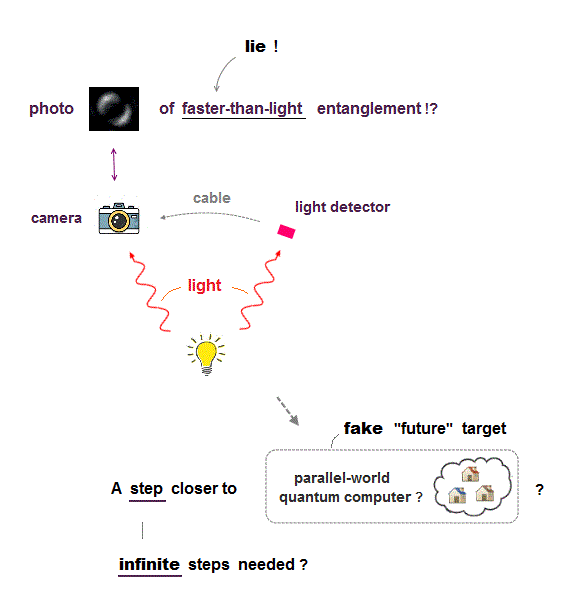
This 6th-paragraph says
"While MRAM pioneers such as Everspin... it remains a niche memory (= forever )"
Because MRAM is energy-inefficient, slower, lower-endurance. more error-prone than DRAM.
This-challenges & limitation (5/28/2025) says
"MRAM technology still faces several important challenges that must be addressed before achieving widespread adoption: ( this 2nd-paragraph )"
The 2nd paragraph of this site (8/2023) says
"There are still plenty of skeptics when it comes to MRAM,.. That has limited MRAM to a niche role over the past couple decades, hampered by high costs, low density, and lower endurance (= short-lifetime MRAM )" ← MRAM is far inferior to today's mainstream SRAM without spin.
This-middle~lower-What challenges does the MRAM market face ? (5/17/2025) says
"Another challenge is the technical complexity involved in scaling up MRAM production... there are still hurdles in improving performance, density, and cost-efficiency at large-scale manufacturing levels. Furthermore, MRAM's ability to compete with established memory technologies, such as DRAM and Flash, remains a challenge.... convincing manufacturers to switch to MRAM requires significant effort in terms of cost-benefit analysis and technological advantages."
This (5/23/2025) says
"However, their (= MRAM ) widespread adoption faces several challenges related to scalability"
This 14th-paragraph (8/5/2024) says
"Technologies like ReRAM, MRAM, etc. will remain niche embedded market alternatives because of this restriction ( this 2nd-last paragraph )".
The 3rd-last-paragraph of even this hyped site (3/5/2025) says
"it will take another decade or so before these alternative memory (= MRAM ) technologies supplant Flash memory and SRAM in embedded applications (= No progress )"
↑ So contrary to the overhyped media, the spintronics or MRAM is already deadend with No hope of progress.
(Fig.2) Spin-torque, MRAM, spintronics cannot be predicted by quantum mechanics. Electron spin is unreal.
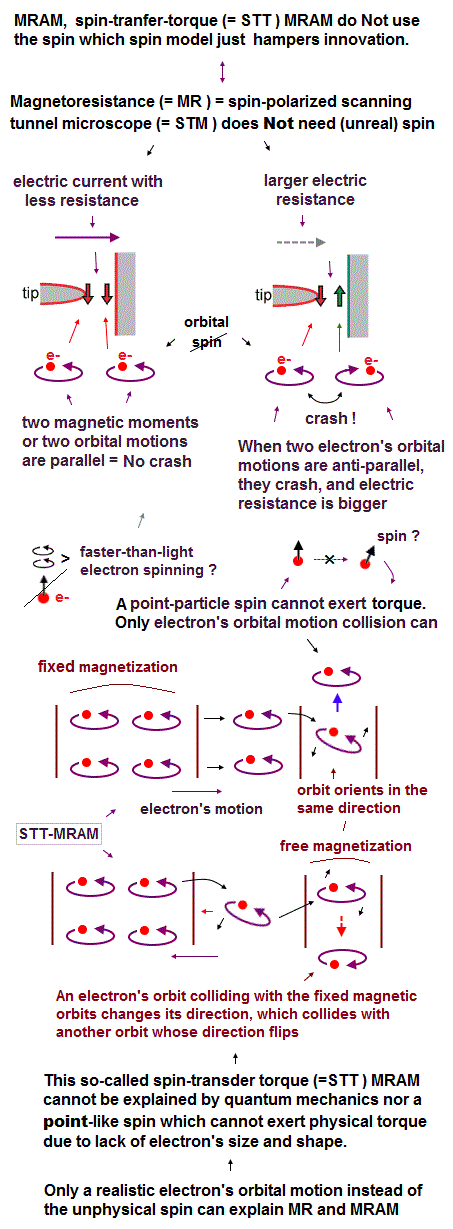
The present mainstream ( niche ) magnetic MRAM memory is spin-transfer-torque (= STT)-MRAM as seen in Everspin.
This STT-MRAM's mechanism can be explained by giant magnetoresistance (= GMR ) that disagreed with quantum mechanics and unphysical spin, contrary to the misleading news.
As shown in the upper figure-①, when electrons' current ( consisting of orbits, Not the unphysical spin ) flows through the fixed magnetization (= ferromagnetic ) layer (= magnetization caused by electron's orbit, Not by spin ) toward the right-side free-magnetization layer, the free layer's magnetization tends to have the same magnetization as the fixed layer, because the electrons' orbits in the opposite magnetization are rebounded by (= cannot penetrate ) the fixed layer due to increased resistance by crash between the opposite orbits in magnetoresistance.
As a result, in the case of upper figure-①, the free (= thin ) layer in the right side comes to have the same magnetization as the fixed layer (= which is bit "0" state ) dominated by the electrons' orbits flowing through fixed layer (= having the same magnetization as the fixed layer ) ( this 12~13th-paragraphs, this p.7, this p.41 ).
When electrons' current flows from the right side as shown in the upper figure-② electrons' orbits whose magnetization is opposite to the fixed layer tend to rebound off the fixed layer back to the free layer (= due to magnetoresistance ), and the free layer's magnetization becomes opposite to the fixed layer (= bit "1" state, this p.23 ) occupied by the electrons' orbits (= Not spin ) rebounded by the fixed layer.
As shown here, spin-transfer-torque MRAM can be naturally explained by electrons' orbits (= magnetoresistance ), which has nothing to do with the fictional spin's torque.
(Fig.2') Overhyped media tends to hide inconvenient truth about the energy-inefficient, slow, spin MRAM with short lifetime

This 1st-paragraph says
"Magneto-Resistive Random Access Memory (MRAM) has so far generally failed to replace SRAM (= using electric current transistors instead of the unphysical spin ) because its Spin Transfer Torque (STT-MRAM) implementation is too slow and doesn't last long enough."
This-p.2-left-1st-paragraph says
"The long write latency (= slower ) and the limited write endurance of
STT-MRAM are critical obstacles preventing it from directly
substituting SRAM cells"
This-STT-MRAM-3~4th-paragraphs say
"But it also creates damage in the (STT-MRAM) cell, which contributes to wear-out."
"Because the performance (of MRAM ) is slow, it will be difficult to replace SRAM"
This-middle-MRAM technology status and challenges-3rd-paragraph (8/28/2025) says
"Write endurance represents another major hurdle for STT-MRAM implementation in cache applications. Current STT-MRAM cells typically demonstrate endurance in the range of 10^6 to 10^9 write cycles, which falls short of the requirements for L1/L2 cache applications that demand 10^15 or more write cycles." ← STT-MRAM has too short-lifetime.
This p.1-introduction-1st-paragraph says
"STT-MRAM faces various challenges along with
its merits such as, the reliability of a tunnel barrier, long write latency and small energy efficiency due to still high
write current."
This-p.4-last~p.5 says
" STT-RAM has Not yet reached sufficient maturity to be introduced in
mass-produced devices. The critical current, required for the switching, is still too high for real-world applications." ← STT-MRAM is energy-inefficient, which is why it cannot be mainstream.
This-p.2-left-2nd-paragraph says
"STT-MRAM still
exhibits higher write energy and latency. This is primarily
attributed to the need for large write voltages and long write
pulse durations to ensure reliable switching of the magnetization. The high writing cost of STT-MRAM presents a major
barrier"
↑ Spin-transfer-torque (= STT )-MRAM memory relies on stochastic collision of electrons' orbits (= Not unreal spin ), which take more time and energy than the present mainstream non-spin SRAM, DRAM memory (= faster, energy-efficient ) that can easily change bit state by simply applying voltage or flowing small amount of electricity.
(Fig.M) Quantum mechanical unreal model is useless, unable to predict spin nor MRAM.

Quantum mechanics unable to predict any multi-electron atoms has to describe any materials as unreal quasiparticle or one-pseudo-electron DFT model with artificially-chosen pseudo-potentials, which can Not predict any spin-related phenomena such as spin-transfer-torque-MRAM.
So No evidence of electron spin theoretically nor experimentally.
In fact, quantum mechanics, which is unable to predict the mechanism of (spin-transfer-torque)-MRAM, has to artificially fit free parameters of unphysical spin-torque toy model or equation ( this p.14-31 = classical LLG model, this-p.4 ) to experiment ( this p.5-lower, this p.3-TableI, this p.10-right, this p.3-left-last-paragraph ).
This p.2-right-last~p.3 says "We used equation (2) to fit the experimental results by choosing βST, βFT, resonance angular frequency ω0 and spectrum linewidth ∆ as fitting parameters" ← Reliance on artificially-fitting free parameters means No quantum mechanical prediction of STT-MRAM's fictional spin
This-introduction-1st-paragraph says "A popular method for the description of STT in magnetic multilayers is the model of Slonczewski....
However, it introduces free variables that depend on various system parameters... These parameters are usually determined in a phenomenological fashion ( this-p.17-last )"
This p.18-last-paragraph-3.1.2 says "Note that some parameters are to date Not known fully. In the term aj an unknown polarization function appears. Furthermore the Gilbert damping term is not exactly known." ← No quantum mechanical prediction of STT-MRAM depending on artificially-chosen damping parameter.
This p.24-left-3rd~4th-paragraph says "Both show that the agreement between theory and experiment is still incomplete (= wrong prediction )"
This paper ↓
p.39(or p.28)-last-paragraph says "a fit can be obtained only by leaving numerous free parameters: "
p.121(or p.110)-2nd-paragraph says "where B and C are free parameters"
As a result, there is No evidence of spin in spin-torque-MRAM, which cannot be predicted by quantum mechanics relying on various free parameters.
This research paper (2020) ↓
p.4-lower~p.5 says "STT-RAM has Not yet reached sufficient maturity to be introduced in mass-produced devices. The critical current, required for the switching, is still too high for real-world applications,.. reliability errors can arise" ← energy-inefficient spin-MRAM
p.8-4th-paragraph says "do provide a simple toy (= fictional ) model (= for STT-MRAM)"
p.13 uses various ad-hoc spin model and artificial parameters
p.15-last-paragraph says "In conclusion,... The main disadvantage is that only the free layer is properly simulated, leaving out many possible complications" ← quantum mechanical spin model can Not explain STT-MRAM
(Fig.3) Overhyped spin-orbit-torque (= SOT )-MRAM is far from practical.
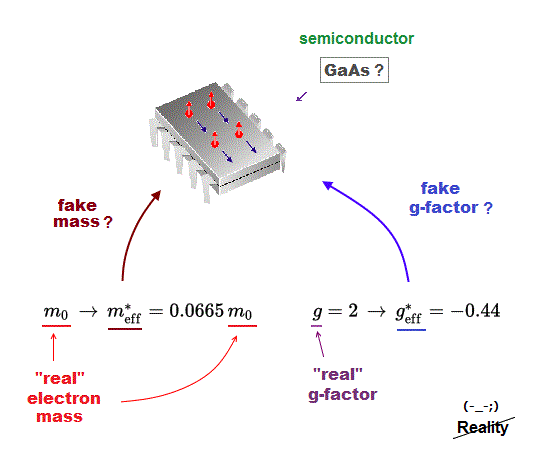
Today's MRAM or STT-MRAM representing spintronics is already deadend, stuck in niche market forever.
They pin all their hopes on new spin magnetic MRAM memory model called spin-orbit-torque (= SOT )-MRAM (= still impractical, this-p.1-left-1st-paragraph ).
SOT-MRAM is said to utilize spin-Hall effect to provide the magnetically-polarized electrons' current (= electric current is scattered by the surrounding electron's orbits into the upper and lower directions depending on its magnetization direction by classical Magnus effect ) to each memory ( this 2nd-paragraph, this 2nd-paragraph ). ← This mechanism is stochastic, unreliable, impractical.
Electron's spin is unreal, and relativistic spin-orbit effect allegedly used in spin-Hall effect is paradoxical, wrong.
This spin-Hall effect can be naturally explained by realistic electron's orbit veering into the upper or lower directions due to classical Magnus effect (= friction between the orbiting electrons and their surroundings ).
Actually, the unphysical quantum mechanical spin model still can Not clarify the mechanism of this spin-orbit-torque (= SOT )-MRAM, as this-p.1-right-last-paragraph (2020) says
"the physical mechanism of SOT still remains to be clarified"
(Fig.3') Spin-SOT MRAM memory needs many additional bulky devices, which is useless, cannot be scaled up.
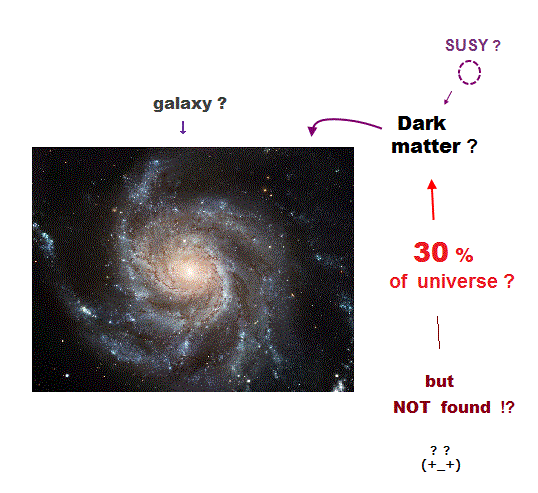
Today's deadend spintronics places all its hope on the spin-orbit-torque (= SOT )-MRAM as a "promising" memory potentially replacing today's non-spin SRAM.
But this current only hope SOT-MRAM can never be of practical use nor outperforming today's mainstream non-spin SRAM or DRAM memory.
Because SOT-MRAM must use two-different electric currents in two different directions (= bit reading and bit writing must use different electric currents in different directions in SOT-MRAM ), which take too much space to be practical ( this-2nd-last-paragraph ).
This-middle-MRAM technology status and challenges-5th-paragraph (8/28/2025) says
"SOT-MRAM technology remains in the research and development phase, with No commercial products yet available. Key challenges include higher manufacturing complexity due to the three-terminal design, increased cell size compared to STT-MRAM."
This-middle-Reducing the bit-cell size says
"A more challenging issue is the fact that while the STT cell has two terminals shared by read and write currents, the SOT cell has three terminals, since the write current has its own path. That means another select transistor. This is the default configuration, and it makes for a larger bit cell than STT has. "
"Nevertheless, the SOT cell is still bigger than the STT cell,... it's unclear whether they will be commercialized."
One bit size of today's non-spin SRAM, DRAM transistor and hard-disc drive is less than 50nm, which is far more compact and smaller than the impractical bulky SOT-MRAM bit size > 540nm ( compare this p.6-compact-hard disc and p.41-bulkier-SOT-MRAM, Compare this-p.3-Fig.1-bigger-SOT and this-SRAM ).
Requirement for additional peripheral electric-current instruments prevents SOT-MRAM from scaling up to the the practical memory ( this-2/27/2025, This-last-paragraph-1/29/2024, this-p.5-right-2nd-paragraph ) forever.
This introduction-1st-paragraph (2024) says
"However, a challenge for SOT-MRAM is that each bit cell requires two access transistors, resulting in a larger unit area (= miniaturization is impossible ), limiting its application in high-density memory scenarios."
This-last-paragraph (1/29/2024) says
"it needs high currents for write operations, so its dynamic power consumption is still quite high (= energy-inefficient ). Furthermore, SOT-MRAM cells are still larger than SRAM (= today's mainstream non-spin memory ) cells, and they are harder to make. As a result,.. it is unlikely that it will replace SRAM" ← spintronics MRAM is hopeless.
This-p.4-lower says
"Lowering the energy demand and enhancing the energy efficiency is an outstanding problem for the SOT-MRAM.
Today, though, the biggest problem with SOT-MRAM is that it only switches about 50% of the time (= too many errors to be practical )."
Today's mainstream non-spin SRAM is faster, more energy efficient, needing smaller energy of only less than 20 fJ/bit operation than energy-inefficient SOT-MRAM needing more than 100 fj energy in writing its bit ( this-p.5-Table II, this-3rd-last-paragraph, )
Spin-orbit-torque (= SOT ) MRAM is not only more energy-inefficient but also slower than the current mainstream non-spin SRAM memory.
↑ This-p.12-Fig.11 shows the spin-torque-STT and SOT-MRAM consume much more energy (= WR or writing energy = ~100 fJ ), and are slower (= RD or reading latency = 3 ~ 10 ns ) than today's mainstream non-spin SRAM memory (= WR energy < 28 fJ, latency < 1 ns = energy-efficient and faster ).
(Fig.H) "Dreamlike SOT-MRAM is promising, potentially surpassing today's SRAM memory" is a lie.
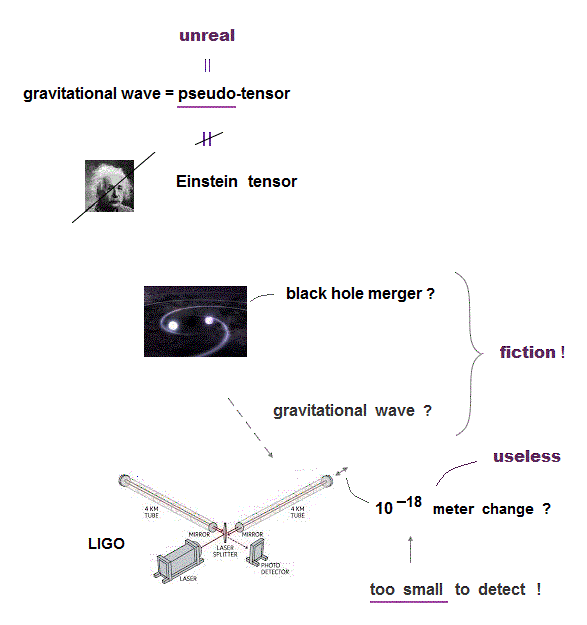
The 1st, 6th paragraphs of this (5/20/2025 or this ) just vaguely says
"This finding may (= just speculation, so SOT-MRAM is still useless ) lead to revolutionary advancements in memory storage device technology that also contribute to a greener, more efficient future."
"As a result, they achieved the world's lowest write power of 156 fJ in 75° canted SOT devices" ← SOT-MRAM wastes more energy than today's SRAM needing only 21.5 fj ( this-p.12-(b)-SRAM-WR energy )
The last paragraph of this overhyped news (3/20/2025) also says
"it's uncertain exactly how well this new technology will hold up under consistent use (= still impractical MRAM ),.. Like most emerging technologies, it's unlikely that MRAM will be seen on laptop spec sheets anytime soon,"
The 2nd, 5th paragraphs of this overhyped news (2/6/2025) say
"Their innovation, based on Spin-Orbit Torque (SOT) Magnetic Random-Access Memory (MRAM), offers a highly efficient and powerful solution for data processing and storage—a transformative step (= still unrealized ) forward for technologies ranging from smartphones to supercomputers."
"However, one key challenge has been to reduce the high input current required during the writing process"
↑ This research-p.4-Fig.3(b) shows this spin-MRAM bit needing external magnetic field H (= Fig.3b ) is impractically larger and bulkier (= 1000nm ) than the non-spin DRAM of 50nm.
This-p.1-right-1st-paragraph (4/2/2025) says
"To
obtain deterministic switching, a small external symmetry
breaking magnetic field is applied along the direction of
charge current. To provide an external magnetic field onchip requires more complicated setup and is therefore the
major roadblock for the industry adoption of SOT-MRAM ( This-Fig.3-lower )."
This-middle-current challenges in SOT-switching.. (8/25/2025) says
"One of the primary obstacles remains the high current density requirement for reliable switching"
"The deterministic switching of PMA (= perpendicular magnetic anisotropy ) devices without external magnetic fields represents another significant hurdle. While (magnetic-)field-free switching has been demonstrated... each method introduces additional complexities,,,, often compromising the scalability ( this-SOT-MRAM challenges )"
The recent research paper on spin-orbit-torque or SOT-MRAM in 2024 ↓
p.1-rigt says ". This renders STT-MRAM unsuitable for ultrafast applications such as cache memories. Moreover, the single path for both reading and writing makes it challenging to attain reliable reading operations." ← No improvement in the problematic STT(= spin-transfer-torque )-MRAM
"However, the development of SOT-MRAM for ultrafast applications still remains challenging (= both STT and SOT-MRAM are still useless, problematic )"
p.2-Fig.1a shows even this latest SOT-MRAM switch is very bulky, as large as micrometer (= μm = 1000nm ), which is far bigger and bulkier than today's compact DRAM memory of only 20 nanometers.
p.3-Fig.2 shows switching probability (= PSW ) of this SOT-switch is bad and uncertain between 80 ~ 100% (= about 10% error rate ), which is too error-prone to be a practical memory.
p.5-right just artificially chose free parameters without quantum mechanical prediction nor calculation ( this p.2-STT-SOT model, p.3-Table.1,p.7-methods also used input free parameters without quantum mechanical prediction, depending on chosen model, this-p.6-7, this-p.5 ).
Actually, in this-p.3 6th-paragraph, reviewer #2 says
"On the other hand, the study focuses on micro-sized magnetic dots, and it is well-documented that
reversal mechanisms and energies are very different in µm compared to sub-100 nm dots.
Meanwhile, practical applications are clearly projected for sub-100 nm dimensions (= so this device of micro-meter size is too big to be practical )"
"..In Figure 2, the switching probabilities hardly converge to 100%, but they are not zero either. I raise some doubts about the switching reliability (= this latest SOT-MRAM switch is too erroneous )"
This research paper on SOT in 2024 ↓
p.2-Fig.1c shows this SOT-switch is too bulky and big = about 10μm (= scale bar )
p.4-Fig.3-D shows this SOT-switch is too slow, one switch took about 3~5 seconds, and stochastic, unreliable ( this p.5-Fig.4-d ).
As a result, spin-orbit-torque or SOT-MRAM is too error-prone, too slow, too bulky to be practical, contrary to the media hype.
Quantum mechanics has to rely on unrealistic negative kinetic energy in tunnel current over extremely narrow space (= ~ nm ).
↑ In such a narrow space, their estimation of the potential barrier is wrong, and electrons can realistically flow over very short distance by thermal fluctuation or de Broglie wave interference pressure (= de Broglie wave has 'power' to push electrons and cause interference pattern ) even without the impossible negative kinetic energy (= so tunneling is Not the occult quantum mechanical phenomenon but realistic electron's current with positive kinetic energy by thermal fluctuation and de Broglie wave interference ).
(Fig.S) Overhyped fake news about (deadend) SOT-MRAM is rampant.
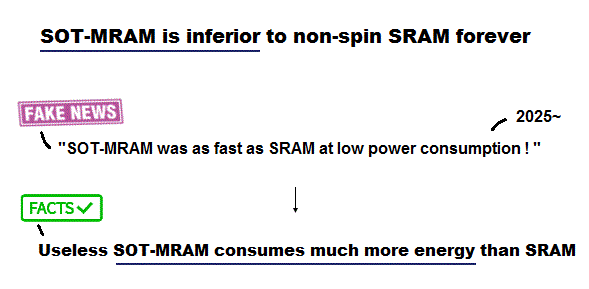
The 4th-paragraphs of this hyped news (10/13/2025) say -- SOT-MRAM hype
"Now it (= SOT-MRAM ) has been improved to ~1ns, rivaling (non-spin practical) SRAM"
This-last-paragraph says -- Useless MRAM
"We now aim to (= just "aim", still unrealized ) move beyond proof-of-concept arrays toward megabit-class integration, while further reducing the write current to below sub-picojoule/bit levels,"
↑ This research paper ↓
p.12-1. says SOT-MRAM needs additional magnetic field generator (= field-free is hard ) in additional to electric field, which makes SOT-MRAM impractical and bulky ( this-middle-Current challenges in SOT switching.. ).
p.17-S12 shows for SOT-MRAM to be as fast as the current non-spin-SRAM (< 1ns = switching time ), SOT-MRAM has to consume much more energy and current (> 150μA ×1ns × 1.5V = 225fJ , this-p.7-2nd-paragraph ) than SRAM (< 40μA or 20fJ, this-p.12-Fig.11-b ).
This-Section II-2nd-paragraph says -- SRAM less energy
"To achieve SRAM level of write energy, we need a write current lower than 40μA."
↑ So SOT-MRAM, which is slower and more energy-inefficient, is inferior to the current non-SRAM forever.
(Fig.4) Only 4 elements (= Fe, Co, Ni, Gd ) can be ferromagnets usable for magnetic memory devices, which have already be known, so No more progress nor discovery.
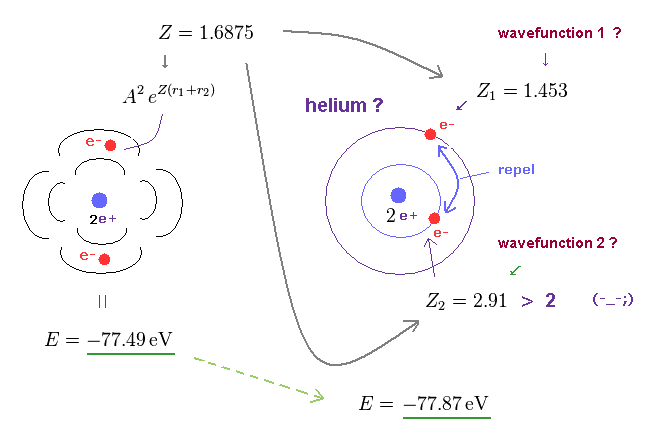
Practical magnetic memory devices such as hard disc and MRAM always need ferromagnets as the source of strong stable magnetization.
But there are only four ferromagnetic atoms = Fe, Ni. Co, Gd whose electromagnetic properties have already been investigated and known.
↑ It means there will be No more progress nor new discovery of dreamlike magnetic ( ferromagnetic ) materials usable for more energy-efficient magnetic memory devices.
So today's deadend quantum mechanics or spintronics researches (= investigating only macroscopic electromagnetic properties of materials ) started to focus on useless materials such as antiferromagnets and altermagnets (= just ordinary antiferromagnets, Not new materials ) with zero magnetization, which can never be used for practical magnetic memory devices ( this-p.30-3.1 ) which need strong magnetization.
Or many researches are conducted at impractically low temperature, because there is almost nothing left to study at the practical room temperature in today's deadend quantum mechanical or spintronics research ( this-11th-paragraph, this-p.2-Fig.2 conducted at very low temperature of T = 25K ).
The unphysical quantum mechanics can only describe observed (macroscopic) electromagnetic properties of materials as fictional quasiparticle models that are overhyped, useless (= fictional skyrmion quasiparticle racetrack memory ), unable to clarify the real microscopic atomic mechanism forever.
The only way to break the current deadlock physics is to use useful multi-probe atomic force microscopes for observing and manipulating single atoms and molecules to design and build atomic-level nano-devices, which is hindered by the unphysical quantum mechanical model.
(Fig.M) Deadend spintronics focuses only on hopeless antiferromagnets with zero magnets as a (fake) promising future magnetic memory.
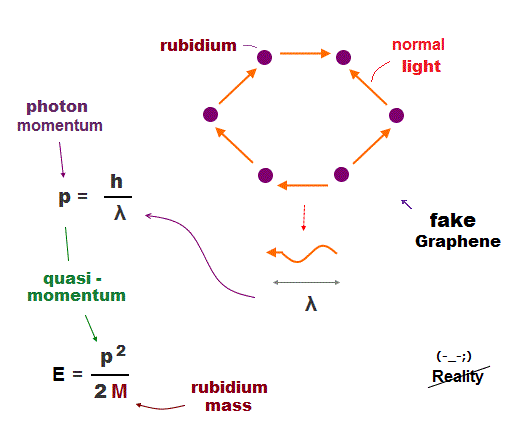
This-p.1-left-1st-paragraph says
"One of the most thrilling challenges that currently limit
the application of antiferromagnetic spintronics is the
lack of large and robust magnetoresistance (MR) effect
comparable to that in ferromagnetic tunnel junctions."
"For high-density memory applications, the structure could be resistive, electric current-driven, and it should have MR (= magnetoresistance ) not less than 100%. Unfortunately, No AFM(= antiferromagnetic )-based structure can satisfy all these demands at the same time at the moment." ← antiferromagnets with zero magnetization are useless as magnetic memory devices.
The last paragraph of this or this overhyped news (3/23/2025) says
"There are many challenges ahead, including innovative approaches for designing and synthesizing materials," ← still antiferromagnetic spintronics is useless with a lot of challenges.
The last paragraph of this hyped news (5/13/2023) says
"A further challenge, the researchers say, will be to figure out a way to electrically manipulate the magnetization on the A-type antiferromagnet so they can construct fully functioning spintronic devices."
↑ The present spintronics researches waste time in hopeless antiferromagnet or altermagnet (= no usable magnetization ) as a only hope for new magnetic devices.
This overhyped paper's abstract (6/10/2025) says
"Antiferromagnets have attracted widespread interest due to the advantages of no stray fields and ultrafast switching dynamics, promising (= still useless ) for next-generation high-speed, high-density memories. However, over a long period, the effective detection of antiferromagnetic (AFM) orders remained being one of the greatest challenges of its application in magnetic random access memories (MRAM) because of its zero net magnetization."
"Our work provides a promising device structure for future (= still useless after all ) nonvolatile high-speed, high-density, and multiple-state AFM memories."
This research paper in all-antiferromagnetic memory devices (2023) ↓
p.2-inroduction-2nd-paragarph says "However, the practical realization of AFM (= antiferromagnet ) memory devices requires mechanisms for both manipulation and detection of AFM order by electrical means. Until recently, the electrical detection of the magnetic state in AFM structures exclusively relied on the anisotropic magnetoresistance (AMR) and spin Hall magnetoresistance (SMR) effects, which provided relative resistance variations (ΔR/R) that were too small for memory applications"
p.3-Fig.1 shows this antiferromagnetic device is impractical, much bulkier (= bigger than 10μm ) than today's practical DRAM memory of only 50nm.
p.7-Fig.4 shows each antiferromagnetic switch change needed more than 10 writing attempts (= one writing operation alone can Not change the useless antiferromagnetic bit state ), which is unreliable and too time-consuming.
p.9-last says "will (= just speculation, still useless ) open new possibilities for a wide range of AFM spintronics experiments (= just for publishing papers to academic journals, Not for practical use )"
(Fig.A) Antiferromagnetic memory is too error-prone, too bulky, impractical.

The 4th, 6th, 2nd-last paragraphs of this hyped news (8/29/2025) say
"antiferromagnets enable high-speed, high-efficiency memory operations in the gigahertz range, outperforming their ferromagnetic counterparts" ← fake news
"the device demonstrated 1,000 error-free switching cycles (which means the error rate is too high = 1/1000 = too error-prone to be useful memory )"
"These results mark a significant step (= still useless ) toward next-generation semiconductor device technology powered by antiferromagnets (= irrelevant to spin )."
This antiferromagnetic memory is useless, far bulkier (= one bit is more than 20μm = 20000nm, this-picture-B,C, this-p.2-Fig.1d = same team's device ) than the compact ferromagnetic hard disc drive memory less than 50nm.
Furthermore, this antiferromagnetic memory's error rate is far higher and worse (= 1/1000) than the ferromagnetic hard disc's error rate less than 1/1014.
So "(hopeless) antiferromagnetic memory outperforming ferromagnets" is fake news for today's deadend spintronics.
The 1st paragraph of this hyped news (9/4/2025)
says
"Spintronics,.. processing that utilizes the intrinsic angular momentum ( spin ) of electrons,... This technology promises faster, more energy-efficient data storage and logic devices." ← fake news
↑ This paper's abstract says nothing about any practical use such as (hyped) faster, energy-efficient storage device, contrary to the above fake news.
(Fig.M) Deadend useless spintronics needs overhyped fake news
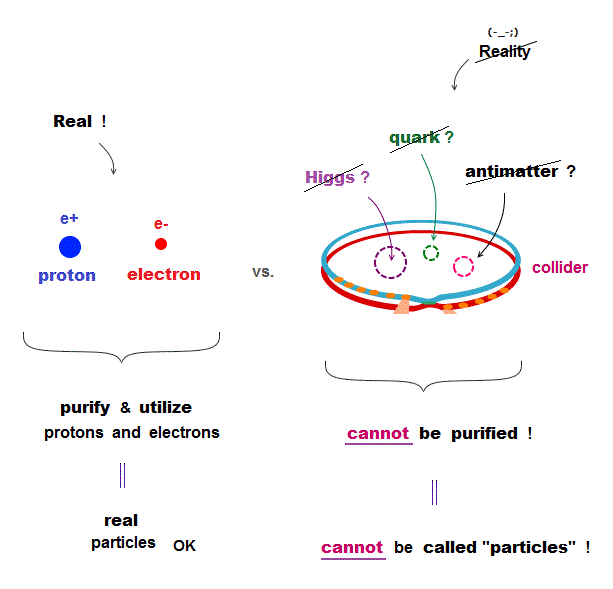
The 5th, 8th, 3rd-last. 2nd-last paragraphs of this overhyped news (6/5/2025) say
"The team discovered the new p-wave magnetism in nickel iodide (NiI2),.. like an antiferromagnet, equal populations of opposite spins result in a net cancellation. " ← so this alleged new p-wave magnetism is just antiferromagnet with zero magnetization that is unsuitable for a practical magnetic memory.
"This breakthrough paves the way for a new class of ultrafast, compact, energy-efficient , and nonvolatile magnetic memory devices." ← wrong
"The team observed p-wave magnetism in nickel iodide flakes, only at ultracold temperatures of about 60 kelvins." ← impractically low temperature
"That's below liquid nitrogen, which is not necessarily practical for applications,"
↑ This p-wave magnetic material is used only at impractically-low temperature of only 60K, which is completely useless, energy-inefficient, contrary to the above hyped explanation.
↑ This research paper ( This ↓ )
p.9-Figure 3c and 3d says "Repeatable polarization switching by applying ±12 MV/m pulsed electric fields at 30 K (= impractically-low temperature ). The photocurrent"
↑ So this research just applied ± electric pulses to some antiferromagnet at impractically-low temperature where the direction of electric current (= photocurrent ) excited by light was measured to be changed extremely slowly (= at intervals of 100s ) after the ± electric pulses. ← No electron spin was measured. Only photocurrent was measured
↑ So this very slow, energy-inefficient antiferromagnetic switch is completely useless, contrary to the above hyped news.
See also MIT's hyped magnetic transistor.
The 1st and last paragraphs of this hyped news (6/17/2025) say
"A research team.., has demonstrated that strong magnetic fields can effectively regulate laser-induced ultrafast demagnetization (= unusable for actual memory ) in a two-dimensional (2D) van der Waals (vdW) ferromagnet."
"Interestingly, the regulatory effects were more pronounced at elevated temperatures (~200 K = Not room temperature, so impractical device ), highlighting the potential (= just speculation, still useless ) for real-world applications in high-speed magnetic storage"
↑ This research paper's abstract says nothing about any practical use such as high-speed magnetic storage, contrary to the above hyped news.
↑ In this way, there is a wide discrepancy between the overhyped fake science news and the actual paper to hide today's deadend quantum mechanical spintronics researches.
The 2nd, 3rd paragraphs of this overhyped news (6/16/2025) say
"This connection lets researchers control magnetism using electric fields, which could (= just speculation, still useless ) pave the way for super-energy-efficient memory and computing devices"
"At low temperatures, the atomic spins arrange themselves into exotic magnetic textures"
↑ This research paper's p.7-methods-left say this research was conducted at extremely low temperature less than 60K, which is completely impractical, energy-inefficient, contrary to the above hyped news.

Feel free to link to this site.